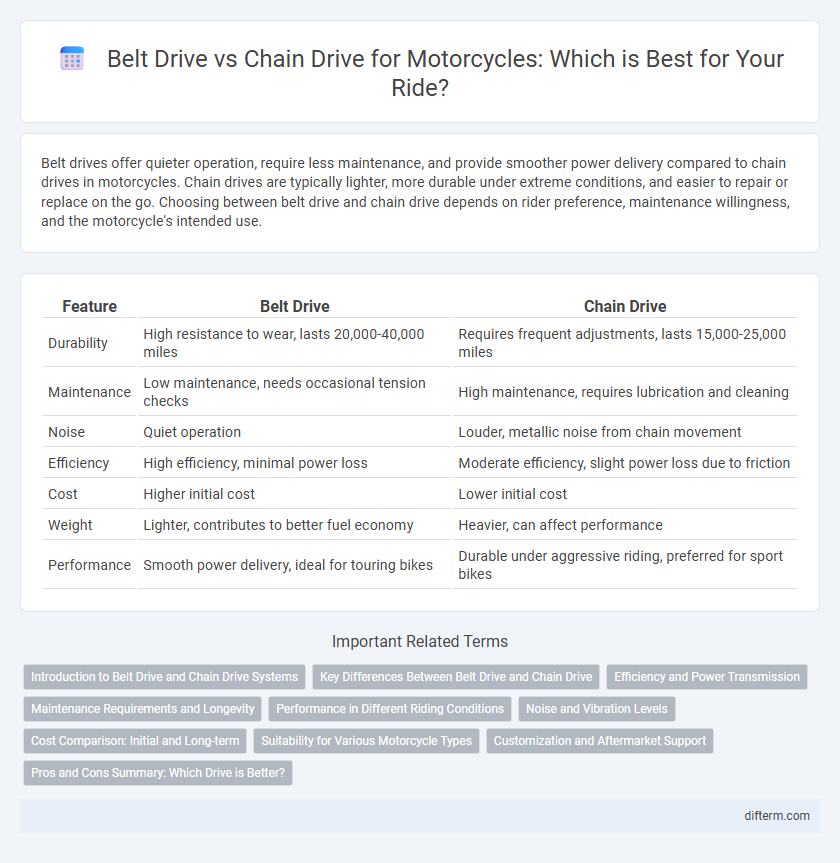Belt drives offer quieter operation, require less maintenance, and provide smoother power delivery compared to chain drives in motorcycles. Chain drives are typically lighter, more durable under extreme conditions, and easier to repair or replace on the go. Choosing between belt drive and chain drive depends on rider preference, maintenance willingness, and the motorcycle's intended use.
Table of Comparison
| Feature | Belt Drive | Chain Drive |
|---|---|---|
| Durability | High resistance to wear, lasts 20,000-40,000 miles | Requires frequent adjustments, lasts 15,000-25,000 miles |
| Maintenance | Low maintenance, needs occasional tension checks | High maintenance, requires lubrication and cleaning |
| Noise | Quiet operation | Louder, metallic noise from chain movement |
| Efficiency | High efficiency, minimal power loss | Moderate efficiency, slight power loss due to friction |
| Cost | Higher initial cost | Lower initial cost |
| Weight | Lighter, contributes to better fuel economy | Heavier, can affect performance |
| Performance | Smooth power delivery, ideal for touring bikes | Durable under aggressive riding, preferred for sport bikes |
Introduction to Belt Drive and Chain Drive Systems
Belt drive systems in motorcycles use reinforced rubber belts to transfer power smoothly and quietly, offering low maintenance with no lubrication required. Chain drive systems consist of metal links and sprockets, providing high durability and efficient power transmission but requiring regular lubrication and tension adjustments. Both systems impact performance, weight, and maintenance, influencing rider preference based on intended use and riding conditions.
Key Differences Between Belt Drive and Chain Drive
Belt drives offer quieter operation and require less maintenance compared to chain drives, which demand regular lubrication and tension adjustments. Chain drives provide superior power transmission efficiency and durability under high-stress conditions, making them favored for performance motorcycles. Belt drives resist corrosion and reduce vibration, while chain drives excel in adaptability for various gear ratios and rugged terrain use.
Efficiency and Power Transmission
Belt drive systems in motorcycles offer higher efficiency due to lower friction and reduced maintenance compared to chain drives, which suffer from metal-on-metal contact losses. Chain drives excel in power transmission by handling higher torque loads and providing quicker acceleration responses, making them ideal for high-performance applications. The choice between belt and chain drive ultimately impacts fuel economy and drivetrain durability, with belts favoring smoother power delivery and chains offering superior strength under extreme conditions.
Maintenance Requirements and Longevity
Belt drives for motorcycles require minimal maintenance, as they do not need regular lubrication and are less prone to stretching compared to chain drives. Chain drives demand frequent cleaning, lubrication, and tension adjustments to prevent wear and extend lifespan. Belt drives typically offer longer service life, often exceeding 20,000 miles, while chain drives may require replacement between 15,000 to 20,000 miles depending on usage and maintenance.
Performance in Different Riding Conditions
Belt drives offer smooth and quiet performance with minimal maintenance, excelling in urban and highway riding by providing consistent power delivery and reduced vibration. Chain drives deliver superior strength and efficiency, making them ideal for aggressive riding, off-road conditions, and rapid acceleration where precise throttle response is critical. Each system's performance varies with riding conditions, with belt drives favored for reliability and low upkeep, while chain drives prioritize durability and high-performance demands.
Noise and Vibration Levels
Belt drives in motorcycles are known for their quieter operation and reduced vibration compared to chain drives, making them ideal for riders seeking a smooth, noise-minimized experience. Chain drives tend to generate more mechanical noise and vibration due to metal-on-metal contact, which can affect ride comfort and require more frequent maintenance for optimal performance. Advances in belt materials such as carbon fiber reinforcement have further enhanced noise dampening and vibration absorption in modern motorcycle belt drive systems.
Cost Comparison: Initial and Long-term
Belt drives typically have a higher initial cost compared to chain drives due to the materials and manufacturing processes involved. Over the long term, belt drives require less maintenance and fewer replacements, leading to lower overall expenses. Chain drives, while cheaper upfront, incur higher costs over time due to frequent lubrication, adjustments, and more frequent component replacements.
Suitability for Various Motorcycle Types
Belt drive systems offer low maintenance, quiet operation, and are ideal for cruiser and touring motorcycles due to smooth power delivery and durability. Chain drives provide superior strength and adaptability, making them suitable for off-road, sport, and dirt bikes that require frequent gear changes and high performance. Shaft drives, although less common, fit well with heavy touring motorcycles by delivering low maintenance and high reliability but add weight and complexity.
Customization and Aftermarket Support
Belt drives offer limited customization options compared to chain drives, which boast a vast aftermarket supply of sprockets, chains, and performance-enhancing components. Enthusiasts favor chain drives for their adjustability in gear ratios and easier repair or replacement, supporting tailored performance needs. The widespread availability of aftermarket parts for chain drives facilitates extensive personalization, making them the preferred choice for motorcycle customization projects.
Pros and Cons Summary: Which Drive is Better?
Belt drives offer quieter operation, low maintenance, and longer lifespan due to less exposure to dirt and debris, making them ideal for casual riders and commuters. Chain drives provide superior power transfer efficiency, easier repair options, and are better suited for high-performance motorcycles requiring frequent tuning and customization. The choice between belt and chain drive depends on rider preferences for maintenance, noise levels, and performance demands.
belt drive vs chain drive (for motorcycles) Infographic

 difterm.com
difterm.com